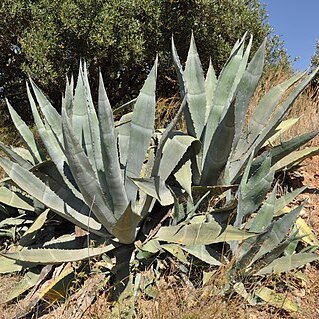Plants succulent, with very short stems and hard fibrous roots, often suckering. Leaves long-lived, succulent, spine-tipped, with or without teeth. Inflorescence occasionally bulbiliferous, bracteate, scapose, spicate, racemose, or paniculate with flowers in umbellate clusters. Flowers bisexual, generally protandrous. Perianth tubular to shallowly funnel-shaped; sepals and petals erect to curved, similar or dimorphic, imbricate in bud. Stamens 6, exserted; filaments inserted in tube or on base of perianth; anthers versatile. Ovary inferior, 3-locular, thick-walled with numerous axile ovules in 2 rows per locule; style elongate, filiform; stigma 3-lobed, papillate. Fruit a loculicidal capsule. Seeds flattened, black.
Plants massive, acaulescent or with a short stout trunk; leaves closely crowded, ensiform, heavily coriaceous, usually armed with spines upon the margin, the tip ending in a stout spine; inflorescence a panicle or paniculate spike, usually massive and many-flowered, but the flowers frequently replaced by viviparous bulbils; perianth funnel-shaped, 6-parted, the tube rather elongate, the lobes subequal, usually greenish white; stamens 6, widely exserted from the perianth, the fila-ments attached to the perianth tube; anthers versatile; pistil 3-celled, containing numerous ovules; style rather short and thick; stigma capitate; fruit a loculicidal capsule containing many seeds.
Plants perennial or monocarpic. Stems very short or indistinct. Leaves in a basal rosette, large, stout, leathery-fleshy or somewhat woody, containing many fibers, margin usually spiny, rarely entire, apex tipped with a spine. Flowering stems branched or simple, tall, stout. Inflorescence terminal, a spike or panicle, mostly very large. Perianth tube short; lobes narrow, subequal. Stamens inserted at throat or in tube of perianth; filament filiform, usually longer than perianth; anther versatile. Ovary with many ovules. Style slender; stigma 3-lobed. Fruit a capsule, oblong, 3-valved, loculicidal. Seeds numerous, black, thin, flattened.
Stout succulent or fibrous perennials. Stem present, or lacking. Leaves crowded in rosettes, large, usually stiff and ± fleshy, leaf-tip ending in sharp spine, margins often toothed. Inflorescence a large raceme or much-branched panicle on a long scape. Flowers bisexual, greenish or brownish. Perianth-segments ± equal, usually green, ± connate into tube, persistent. Stamens 6. Ovary inferior, 3-locular; style filiform; stigma slightly 3-lobed; ovules many in each locule. Capsule loculicidal. Seeds many, thin, flat. Spp. c . 300, of southern N. America and tropical S. America. Adventive sp. 1.
Tep united below, withering persistent on the capsular, trilocular fr; filaments slender, exsert, with versatile linear anthers; ovary inferior; style subulate, with a 3-lobed stigma; seeds numerous, flat, black; monocarpic acaulescent perennials, ultimately producing an erect scape with an elongate, terminal infl of ochroleucous or chloroleucous to yellow or orange fls; 2n=60, 10 large, 50 small. (Manfreda) 300, warm New World.

